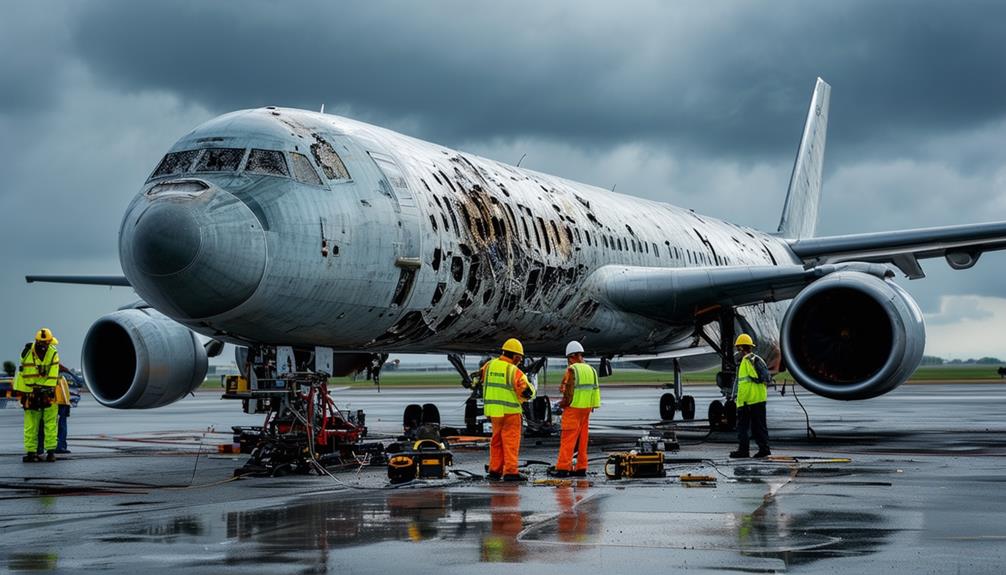The Impact of Lightning on Aircraft Safety

When you think about flying, lightning might not be your first concern, but it's a critical aspect of aircraft safety. Aircraft are struck by lightning multiple times each year, posing potential hazards such as temporary blindness for pilots and disruptions to avionics systems. Engineers have developed advanced technologies to safely channel lightning currents, but the complexities involved are significant.
The FAA has implemented stringent regulations to mitigate lightning-related incidents. But what actually happens during a lightning strike, and how do these measures ensure your safety in the skies?
Frequency of Lightning Strikes
Given their frequent flights through heavily charged cloud regions, U.S. commercial airplanes are struck by lightning more than once a year on average. Aircraft often trigger lightning themselves when flying through these turbulent areas. Despite this, it's not something you need to worry about. The Federal Aviation Administration (FAA) maintains strict safety measures and rigorous record-keeping.
While smaller business and private airplanes are less frequently struck due to their size and ability to avoid lightning-conducive weather, commercial planes don't have that luxury. They fly through various weather conditions, making them more susceptible to lightning strikes. However, it's worth noting that the last confirmed commercial plane crash in the U.S. directly attributed to lightning occurred back in 1967. This historical data highlights modern aircraft's resilience and the effectiveness of current safety protocols.
Even though record-keeping isn't perfect, the FAA mandates thorough lightning certification tests for all commercial airplanes. These tests verify that aircraft can withstand lightning strikes without compromising passenger safety. So, while lightning strikes are common, the robust design and strict regulations ensure your flight remains safe.
Aircraft Lightning Protection
You might be surprised to learn how crucial conductive path engineering is for aircraft safety during lightning strikes. Modern airplanes, including those constructed from composite materials, incorporate conductive elements to channel lightning currents away from sensitive areas. This ensures that critical systems and passenger safety are maintained.
Conductive Path Engineering
To ensure aircraft can safely handle lightning strikes, engineers meticulously design conductive paths to channel electrical discharges away from critical systems. When lightning strikes, these paths ensure efficient flow of electrical current, thereby protecting essential components from damage. Lightning protection systems are critical for maintaining the safety of passengers and crew during such events.
Aircraft skins are usually made of aluminum, an excellent conductor of electricity, facilitating the safe dissipation of lightning currents. In modern aircraft, particularly those constructed with composite materials, engineers embed conductive layers to effectively direct lightning currents away from sensitive equipment. These measures are vital for preventing power surges that could damage avionics and other crucial systems.
Here's how different types of aircraft manage lightning strikes:
| Aircraft Type | Conductive Path Strategy |
|---|---|
| Traditional (Aluminum) | Utilizes the aluminum skin to conduct electricity away from critical areas |
| Modern (Composite) | Integrates conductive layers within composite materials to safely channel currents |
This approach ensures that both traditional and modern aircraft can withstand lightning strikes while protecting vital systems and maintaining overall safety.
Composite Material Safeguards
Building on the conductive path strategies, composite materials in modern aircraft enhance lightning defense through embedded conductive layers that efficiently carry and disperse electrical charges across the aircraft's structure. When lightning strikes, these pathways ensure the energy is spread out, minimizing potential damage.
Composite materials not only offer structural integrity but also improve lightning protection. Aircraft skins made from these materials are designed to withstand the intense energy from a lightning strike, thereby safeguarding the aircraft's essential systems and passengers. Engineers meticulously design these skins to handle the electrical load without compromising the aircraft's performance or safety.
Additionally, lightning protection engineers play a crucial role in safeguarding sensitive onboard equipment. They employ advanced techniques to prevent power surges from impacting avionics and other critical systems. By integrating these safeguards, the risks associated with lightning strikes are significantly reduced.
Fuel Systems and Radome Safety

Ensuring the safety of fuel systems and radomes against lightning strikes is paramount for aircraft safety. The Federal Aviation Administration (FAA) enforces stringent regulations to protect both passengers and crew from lightning hazards. Aircraft fuel systems are meticulously designed to prevent sparks, with structural joints and fasteners engineered to withstand lightning currents. This design minimizes the risk of ignition within the fuel system, even in the event of a lightning strike.
Radomes, which house essential radar and flight instruments, are safeguarded using lightning diverter strips. These strips channel lightning away from sensitive components, reducing the likelihood of damage. Additionally, the aircraft skin around fuel tanks is constructed to be thick enough to prevent burn-through, providing an extra layer of protection.
Consider the emotional impact if these safety measures were absent:
- Fear: The thought of a lightning strike igniting fuel mid-air is terrifying.
- Relief: Awareness of these protections can ease anxiety when flying.
- Trust: Confidence in the aviation industry's commitment to safety is reinforced.
These safety protocols ensure that passengers can trust the aviation industry's dedication to their well-being, enhancing overall flight safety.
Private Aircraft Concerns
When flying a private aircraft, it's crucial to recognize the unique risks posed by thunderstorms, especially if your plane is made of unprotected fiberglass or composite materials. While FAA regulations provide some protection, kit-built aircraft mightn't adhere to these standards, making them more vulnerable. Prioritizing lightning protection is essential to ensure the safety of both you and your passengers.
Avoiding Thunderstorm Risks
Flying close to thunderstorms poses significant risks for private general aviation planes, including severe turbulence and lightning strikes. To mitigate these hazards, prioritize comprehensive pilot training and adhere to rigorous safety protocols.
Proper pilot training equips you to handle unexpected situations effectively. Implement robust weather monitoring and thorough flight planning as essential practices. Always check weather forecasts and radar images before departure to identify and avoid stormy regions.
When planning your flight, consider alternate routes and be prepared to adjust your course if thunderstorms develop along your path. In the event you encounter severe weather, knowing emergency procedures and practicing lightning avoidance techniques can be crucial.
- Imagine the fear of being caught in sudden turbulence.
- Consider the financial cost of repairing lightning damage.
- Think about the lives at stake with every flight.
If you fly a kit-built composite aircraft, your risk increases due to the lack of built-in lightning protection. Therefore, exercise extra caution and avoid flying close to thunderstorms altogether. By adhering to these guidelines, you can significantly reduce the risks associated with stormy weather and ensure safer flights.
Lightning Protection Regulations
Understanding lightning protection regulations is critical, especially for private aircraft pilots navigating the skies. The FAA has established specific compliance requirements to ensure that small commercially-made aircraft with aluminum skins have fundamental protection against lightning strikes. This involves lightning strike analysis and safety measures to reduce the risks associated with flying in stormy conditions.
For pilots flying composite aircraft, it's crucial to be aware of their unique vulnerabilities. Composite materials, such as fiberglass, lack the conductive properties of aluminum, making them more susceptible to lightning damage. Unlike aluminum-skinned aircraft, composite aircraft aren't subject to stringent FAA lightning protection regulations, increasing their risk in adverse weather.
To mitigate these risks, follow best practices: always check weather forecasts, avoid flying near thunderstorms, and consider installing aftermarket lightning protection systems.
While FAA regulations may not mandate lightning protection for kit-built composite aircraft, proactive safety measures can significantly enhance safety. By understanding these vulnerabilities and implementing effective prevention strategies, you can improve your aircraft's safety and ensure smoother, safer flights.
Kit-Built Aircraft Vulnerabilities
Kit-built composite aircraft are notably vulnerable to lightning strikes due to the absence of mandatory protection regulations. Unlike small commercially manufactured aircraft with aluminum skins, composite aircraft are more prone to the consequences of lightning. The non-conductive materials used in these aircraft don't naturally dissipate lightning's immense electrical energy, potentially leading to structural damage and safety hazards.
The FAA doesn't mandate lightning protection for kit-built planes, which heightens their vulnerability. This lack of regulation places greater responsibility on pilots to ensure their safety. It's crucial to take precautions, such as avoiding flying near thunderstorms and always checking weather forecasts before taking off.
Pilot safety is paramount, and taking extra steps can make a significant difference. Consider installing aftermarket lightning protection systems on your aircraft. Although not required, these precautions can help mitigate the risks associated with lightning strikes.
Taking proactive measures can significantly enhance safety and reduce the risks associated with lightning strikes in kit-built aircraft. Imagine the terror of losing control mid-flight due to a lightning strike. Think about the potential structural damage that can go unnoticed until it's too late. Consider the increased risk to your life and your passengers' lives without proper precautions.
FAA Regulations and Testing

The FAA mandates strict lightning protection regulations for critical aircraft components to ensure safety during lightning strikes. To achieve FAA compliance, manufacturers must adhere to rigorous safety standards. Certification testing is essential, as it verifies that aircraft fuel systems, engines, and airframes can endure lightning strikes without compromising safety.
For instance, companies like Lightning Technologies Inc. (LTI) conduct comprehensive evaluations on fiberglass and composite panels. These tests simulate lightning currents to ensure that the materials can withstand real strikes without suffering catastrophic damage.
It is crucial to note that while commercial aircraft are subject to these stringent requirements, kit-built aircraft, often categorized as experimental, mightn't need to meet the same lightning protection standards. This lack of specific regulations can pose risks, particularly when flying near thunderstorms.
Adequate lightning protection isn't merely a bureaucratic requirement. Inadequately protected composites can endure severe damage, underscoring the importance of FAA regulations. By adhering to these guidelines, manufacturers ensure that aircraft have the best possible defense against lightning, ultimately safeguarding passengers and crew during flights.
Lightning Strike Statistics
While FAA regulations ensure robust lightning protection for aircraft, understanding the frequency and impact of lightning strikes remains crucial. On average, commercial aircraft are struck by lightning 1-2 times per year, with over 90% of these strikes occurring during flight. Although this data highlights a known risk in aviation, it rarely leads to accidents.
Aircraft flying through thunderstorms can enhance ambient electric fields, sometimes causing planes to initiate lightning strikes. Despite the frequency of these events, aviation safety assessments indicate that structural damage from lightning strikes is rare. Instead, the crew might experience brief effects such as temporary blindness and avionics disruptions, which, while unsettling, are generally manageable.
Key points to consider:
- Impact on Crew: Lightning strikes can temporarily blind pilots and disrupt avionics, creating tense but manageable moments.
- Frequency of Strikes: Knowing that planes are struck 1-2 times annually might cause concern, but it's important to understand the measures in place.
- Prevention Measures: Despite the frequency, comprehensive lightning strike prevention and aircraft design ensure that strikes rarely compromise safety.
Damage Inspections and Costs

Given the critical importance of aircraft safety, mandatory inspections following suspected lightning strikes significantly impact both operational costs and flight schedules. When an aircraft is suspected of being struck by lightning, it must undergo comprehensive examinations to detect and repair any potential damage. These inspections aren't only time-consuming but also lead to costly repairs, placing a financial strain on airlines.
Flight disruptions are unavoidable as aircraft are taken out of service for these essential evaluations. This inconveniences passengers and creates logistical challenges for airline operations. The safety protocols in place require meticulous attention to detail to ensure the aircraft is safe for flight again.
Smaller private and experimental planes often lack robust lightning protection systems, making them more susceptible to damage and subsequent expensive repairs. Commercial airlines, however, typically prioritize thunderstorm avoidance to mitigate risks. Despite these precautions, inspections remain crucial due to the unpredictable nature of lightning.
While commercial plane crashes directly caused by lightning are exceedingly rare, the emphasis on safety mandates that airlines conduct these essential checks, despite the operational and financial burdens they impose.
Lightning Risk Management
Managing the risk of lightning strikes on aircraft involves proactive strategies and advanced technologies to ensure passenger safety and operational efficiency. One critical aspect is lightning risk assessment, which involves identifying potential hazards and implementing mitigation strategies.
For example, pilots are trained to maintain a safe distance of at least 20 nautical miles from Cumulonimbus clouds, which are known for their lightning activity. This training includes essential lightning avoidance techniques vital for maintaining a safe flight path.
Another key component is the use of advanced lightning detection technology. These systems help pilots navigate around thunderstorms, thus minimizing the risk of lightning strikes. Additionally, aircraft are equipped with lightning protection systems during regular maintenance to reduce their vulnerability.
Accurate navigation, facilitated by selecting gyro-magnetic compasses, is also vital during lightning risk scenarios.
In the event of a lightning strike, having robust emergency response and lightning strike protocols is crucial. Pilots must be prepared to handle such incidents effectively to ensure the safety of everyone on board.
- The safety of your loved ones is paramount.
- Every precaution is a step towards peace of mind.
- Every training session prepares for the unexpected.
Ongoing Research and Innovations

In the domain of aircraft safety, ongoing research and cutting-edge innovations are crucial for mitigating the risks associated with lightning strikes. Scientists and engineers are tirelessly working to enhance lightning detection and improve the accuracy of lightning data. These advancements are vital for developing more effective safety measures and ensuring robust protocols in aviation.
One notable innovation is BoltAlert, a system designed for the precise diagnosis of lightning threats. BoltAlert's proactive solutions enable airlines and airports to anticipate and respond to lightning hazards before they pose significant risks. Collaborations with experts, such as those from AvMet Applications, Inc., are proving invaluable. These experts help deepen our understanding of how lightning impacts airport operations, ultimately leading to safer skies.
Air traffic simulations are another essential tool in this research. By simulating local lightning events, researchers can analyze their effects on daily airline schedules and make necessary adjustments to improve operational efficiency. The ultimate goal is to characterize the true lightning hazard, thereby enhancing the safety of personnel and passengers alike. With these ongoing efforts, the aviation industry continues to advance towards a future where lightning-related risks are significantly reduced.
Conclusion
In summary, it's important to recognize that while lightning strikes on aircraft are relatively common, comprehensive safety measures are in place to protect passengers. Aircraft are engineered with advanced systems to safely channel lightning currents away from critical components. The FAA enforces strict regulations and conducts rigorous testing to ensure minimal risk. Being informed about these protections can reinforce your confidence in the aviation industry's commitment to safety and ongoing research. Your safety remains the highest priority.




